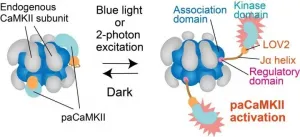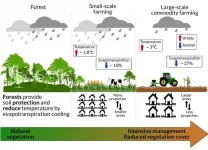(Press-News.org) One of the dozens of unusual symptoms that have emerged in COVID-19 patients is a condition that's informally called "COVID brain" or "brain fog." It's characterized by confusion, headaches, and loss of short-term memory. In severe cases, it can lead to psychosis and even seizures. It usually emerges weeks after someone first becomes sick with COVID-19.
In the February 8, 2021, issue of the journal Cancer Cell, a multidisciplinary team from Memorial Sloan Kettering reports an underlying cause of COVID brain: the presence of inflammatory molecules in the liquid surrounding the brain and spinal cord (called the cerebrospinal fluid). The findings suggest that anti-inflammatory drugs, such as steroids, may be useful for treating the condition, but more research is needed.
"We were initially approached by our colleagues in critical care medicine who had observed severe delirium in many patients who were hospitalized with COVID-19," says Jessica Wilcox, the Chief Fellow in neuro-oncology at MSK and one of the first authors of the new study. "That meeting turned into a tremendous collaboration between neurology, critical care, microbiology, and neuroradiology to learn what was going on and to see how we could better help our patients."
Recognizing a Familiar Symptom
The medical term for COVID brain is encephalopathy. Members of MSK's Department of Neurology felt well-poised to study it, Dr. Wilcox says, because they are already used to treating the condition in other systemic inflammatory syndromes. It is a side effect in patients who are receiving a type of immunotherapy called chimeric antibody receptor (CAR) T cell therapy, a treatment for blood cancer. When CAR T cell therapy is given, it causes immune cells to release molecules called cytokines, which help the body to kill the cancer. But cytokines can seep into the area around the brain and cause inflammation.
When the MSK team first began studying COVID brain, though, they didn't know that cytokines were the cause. They first suspected that the virus itself was having an effect on the brain. The study in the Cancer Cell paper focused on 18 patients who were hospitalized at MSK with COVID-19 and were experiencing severe neurologic problems. The patients were given a full neurology workup, including brain scans like MRIs and CTs and electroencephalogram (EEG) monitoring, to try to find the cause of their delirium. When nothing was found in the scans that would explain their condition, the researchers thought the answer might lie in the cerebrospinal fluid.
MSK's microbiology team devised a test to detect the COVID-19 virus in the fluid. Thirteen of the 18 patients had spinal taps to look for the virus, but it was not found. At that point, the rest of the fluid was taken to the lab of MSK physician-scientist Adrienne Boire for further study.
Using Science to Ask Clinical Questions
Jan Remsik, a research fellow in Dr. Boire's lab in the Human Oncology and Pathogenesis Program and the paper's other first author, led the analysis of the fluid. "We found that these patients had persistent inflammation and high levels of cytokines in their cerebrospinal fluid, which explained the symptoms they were having," Dr. Remsik says. He adds that some smaller case studies with only a few patients had reported similar findings, but this study is the largest one so far to look at this effect.
"We used to think that the nervous system was an immune-privileged organ, meaning that it didn't have any kind of relationship at all with the immune system," Dr. Boire says. "But the more we look, the more we find connections between the two." One focus of Dr. Boire's lab is studying how immune cells are able to cross the blood-brain barrier and enter this space, an area of research that's also important for learning how cancer cells are able to spread from other parts of the body to the brain.
"One thing that was really unique about Jan's approach is that he was able to do a really broad molecular screen to learn what was going on," Dr. Boire adds. "He took the tools that we use in cancer biology and applied them to COVID-19."
The inflammatory markers found in the COVID-19 patients were similar, but not identical, to those seen in people who have received CAR T cell therapy. And as with CAR T cell therapy, the neurologic effects are sometimes delayed. The initial inflammatory response with CAR T cell treatment is very similar to the reaction called cytokine storm that's often reported in people with COVID-19, Dr. Wilcox explains. With both COVID-19 and CAR T cell therapy, the neurologic effects come days or weeks later. In CAR T cell patients, neurologic symptoms are treated with steroids, but doctors don't yet know the role of anti-inflammatory treatments for people with neurologic symptoms of COVID-19. "Many of them are already getting steroids, and it's possible they may be benefitting," Dr. Wilcox says.
"This kind of research speaks to the cooperation across the departments at MSK and the interdisciplinary work that we're able to do," Dr. Boire concludes. "We saw people getting sick, and we were able to use our observations to ask big clinical questions and then take these questions into the lab to answer them."
INFORMATION:
Dr. Boire is an inventor on a patent related to modulating the permeability of the blood-brain barrier and is an unpaid member of the scientific advisory board of EVREN Technologies.
This work was funded by National Institutes of Health grant P30 CA008748, the Pew Charitable Trusts, the Damon Runyon Cancer Research Foundation, and the Pershing Square Sohn Cancer Research Alliance GC239280. It was also supported by the American Brain Tumor Association Basic Research Fellowship, the Terri Brodeur Breast Cancer Foundation Fellowship, and the Druckenmiller Center for Lung Cancer Research.
Exposure to sexual assault in the U.S. military doubled the odds that a service member would leave the military within 28 months, and sexual harassment was associated with roughly 8% of all military separations during this same time period, according to a new report from the RAND Corporation.
Specifically, the report estimates that sexual assaults were associated with 2,000 more separations than would normally be expected, and another 8,000 separations were associated with sexual harassment.
"Sexual assault and sexual harassment are associated with a wide range of harms to individual service members, but this study highlights another negative impact of these crimes - higher rates of attrition and associated harms to force readiness." said Andrew ...
The world is changing rapidly and in order to serve the human population dealing with those changes, American universities need to change, too. In fact, their role is to model the resiliency that all institutions need to embrace, according to Arizona State University President Michael M. Crow.
While many leading universities are poised to advance society and help respond to the challenges of disruptive change through their traditional role in education and discovery, many face a number of barriers that make them less prepared to respond to the rapidly changing conditions and the demands they create.
What is emerging is a new type of university, one that steps beyond the American research university model and ...
Not all friendships are created equal. Some friends get along; others struggle to avoid conflict. Conventional wisdom holds that the tenor of a friendship with someone who is nice differs from that with someone who is mean, such that the former discourages negative interactions whereas the latter aggravates them. Although it is logical to assume that children who are mean have friendships characterized by growing strife and that children who are nice report little of the same, these assumptions have not yet been tested in the real-world friendships of children.
Researchers from Florida Atlantic University's Charles E. Schmidt College of Science are the first to conduct a longitudinal study to examine the extent to which being "nice" (prosocial behavior) and being "mean" (relationally aggressive ...
A new study from University of Alberta researchers has shown that traumatic or stressful events in childhood may lead to tiny changes in key brain structures that can now be identified decades later.
The study is the first to show that trauma or maltreatment during a child's early years--a well-known risk factor for developing mental health conditions such as major depressive disorder in adulthood--triggers changes in specific subregions of the amygdala and the hippocampus.
Once these changes occur, researchers believe the affected regions of the brain may not function as well, potentially increasing the risk of developing mental health disorders as adults during times of stress.
"Now ...
CORVALLIS, Ore. - Marching band members in leadership roles are more likely to feel discomfort in the neck and upper back than their less experienced bandmates, who in turn are more susceptible to left-hand pain and cognitive strain, a new study by Oregon State University suggests.
The findings also showed that gender had no bearing on how much discomfort a musician felt or the band member's perception of workload.
"The study really seems to indicate that a player's level of experience and role within the band are what drive how much discomfort they feel," said industrial ...
Neurons are the primary cells of the nervous system, and the signals that are transmitted between them are responsible for all our actions and our cognitive ability. In particular, learning and memory are believed to be associated with a process called "long-term potentiation," which is the strengthening of connections between specific neurons via continued signal transmission through "synapses" (small gaps between neurons). Long-term potentiation can change the connection between neurons via synapses--by changing their size and composition. Understanding ...
Researchers report that large-scale commercial farms on deforested land in the southern Amazon result in higher temperature increases and less rainfall than small-scale farms.
Deforestation has converted swaths of land in the southern Amazon region from rainforest to farmland. The uses of the deforested land are diverse, and activities can range from small-scale farming in rural settlements to large-scale commodity agriculture. Commercial farms in the Southern Amazon can reach hundreds of thousands of hectares in area, exporting millions of tons in grains and beef every year.
Eduardo Maeda from the University of Helsinki and colleagues used satellite data to compare areas dominated by different land uses and farm sizes to evaluate their impacts on ...
Li-ion batteries (LIBs) are widely used in various mobile electronics. Concerns of global warming and climate change have recently boosted the demand for LIBs in electric vehicles and solar photovoltaic output smoothing. Si has been studied as an active material with a high theoretical capacity of 3578 mAh/g, which is around ten times higher than that of graphite (372 mAh/g).
Now, a team of researchers at Osaka University has used flake-shaped Si nanopowder wrapped by ultrathin graphite sheets (GSs) to fabricate LIB electrodes with high areal capacity and current density.
Generally ...
Rivers and lakes at high latitudes are considered to be major sources for greenhouse gas emissions to the atmosphere, but these losses are poorly constrained. In a study published in Nature Communications, Umeå University researchers and collaborators quantify carbon emissions from rivers and lakes across Western Siberia, finding that emission are high and exceed carbon export to the Arctic Ocean.
High latitude regions play a key role in the global carbon cycle and climate system. An important question is the degree of mobilization and atmospheric release of vast soil carbon stocks, partly stored in permafrost, with amplified warming of these regions. A fraction of this carbon is exported to inland waters and emitted to the atmosphere, yet these ...
Cryopreservation involves preserving biological materials, such as cells, tissues, and organs, at ultra-low temperatures so that they can be revived and used at a later date. To achieve cryopreservation such that the preserved materials are not damaged, scientists use various chemicals called cryoprotectants, which facilitate the freezing process. Unfortunately, many of the existing cryoprotective agents have major limitations. For example, dimethyl sulfoxide is useful for cryopreserving red blood cells, but it is also toxic to the cells.
To overcome these limitations, researchers at the Japan Advanced Institute of Science and Technology (JAIST) and Japan's RIKEN have experimented with a class of chemicals known as polyampholytes, identifying one ...





